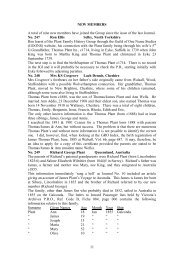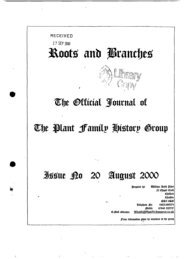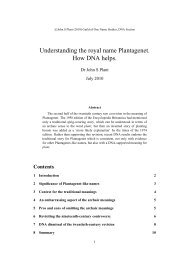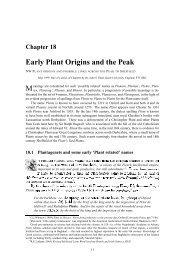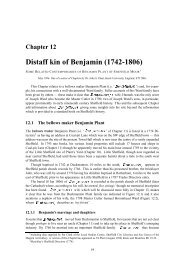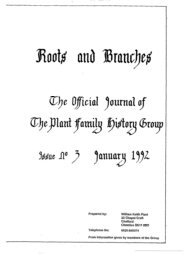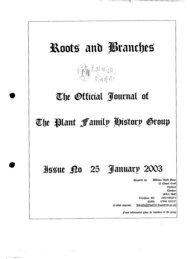Chapter 34 Austin Plant - Plant Family History Group
Chapter 34 Austin Plant - Plant Family History Group
Chapter 34 Austin Plant - Plant Family History Group
You also want an ePaper? Increase the reach of your titles
YUMPU automatically turns print PDFs into web optimized ePapers that Google loves.
Following on from this, it became possible that this situation might need to be re-considered in<br />
the light of a further volunteer (P18a) who came forward for testing. His earliest known ancestor<br />
is James <strong>Plant</strong>, born 1793 in Sibsey to parents Richard and Sarah (née Waltham); James’s sons<br />
emigrated to Australia. Sibsey is in south Lincolnshire, just to the north of Boston. The results for<br />
P18a, however, turned out not to be quite as expected: P18a did not match with the main English<br />
<strong>Plant</strong> family; nor did he match with P17a; but he was a close match to Walter <strong>Plant</strong> (P9a) whose<br />
result was discussed in the previous DNA Report.<br />
There was also a further development for Walter (P9a). His line was originally recorded as being<br />
from ”late nineteenth century Hull”, further up the east coast of England. However, by more recent<br />
research, he had traced his line back to his great-grandfather’s 1862 birth at Stickley, just north of<br />
Boston; and, moreover, his great-great-grandfather was William who was born 27.5.1832 at nearby<br />
Leake East Fen Allotment to John and Eliz (b 1791). The paper trail hence places the ancestors<br />
of Walter (P9a) not far from those of Bill (P18a) around 1800; and this goes some way towards<br />
explaining why their Y-DNA results indicate that there is a 67% chance that they had a common<br />
<strong>Plant</strong> ancestor within the last 24 generations. To check out this finding with more certainty, it would<br />
be beneficial if Bill (P18a) were to upgrade his Y-DNA test results from 12 to 25 markers, though<br />
this would entail Bill’s paying an extra fee. In the absence of extra information from further testing,<br />
we can nonetheless say that, when taken together, the paper trail and the Y-DNA results seem fairly<br />
convincing: there seems little doubt that both Walter and Bill were from the same south Lincolnshire<br />
family around 1800.<br />
It was also discussed, in the previous DNA report, that there was also a 67% chance that Walter<br />
(P9a) had a common ancestor in the past 24 generations with a Javier <strong>Plant</strong>er (PR1a) in Spain. Given<br />
the lack of a similar geographical location, not to mention the slight difference in surname, this<br />
was rather more surprising. It was speculated whether Walter (P9a) and Javier (PR1a) might both<br />
be descended from the Gascony <strong>Plant</strong>e family, for example, for whom we have no direct Y-DNA<br />
results so far. It can be added that Walter (P9a) recalls a family story that his line was from Holland,<br />
which might be in keeping with overseas origins. Ideally, further Y-DNA results are desirable to<br />
check out this apparent cluster of matching Y-DNA results more fully. Though Walter (P9a) has<br />
upgraded his Y-DNA results to 25 markers, Javier (PR1a) did not do likewise. Perhaps more clarity<br />
will emerge when, for example, some Gascony <strong>Plant</strong>es come forward to be tested.<br />
Thus, though the full details of the situation for Walter (P9a), Javier (PR1a) and Bill (P18a)<br />
are still not entirely clear, their results suggest a secondary Y-DNA <strong>Plant</strong> cluster, associated in<br />
part with south Lincolnshire around 1800. It is possible that this may relate back to the early<br />
south Lincolnshire cluster that is found in the pre-1700 <strong>Plant</strong> Name Distribution data. Whether this<br />
also relates to a family connection with Javier <strong>Plant</strong>er in Spain is not certain (just a 67% chance).<br />
However, this could offer one possible explanation of why this south Lincolnshire <strong>Plant</strong> family,<br />
around 1800, does not match with the main English <strong>Plant</strong> family: the south Lincolnshire <strong>Plant</strong>s<br />
may have originated overseas. It has to be added, however, that another possible explanation is that<br />
there was a false paternity event before 1800 in the descent of this south Lincolnshire <strong>Plant</strong> family;<br />
and, furthermore, if there is truly a family connection to Javier <strong>Plant</strong>er’s line in Spain, which he<br />
has traced back to around 1840, the connection could have originated with a south Lincolnshire<br />
<strong>Plant</strong> travelling to Spain rather than because the south Lincolnshire <strong>Plant</strong> cluster originated from<br />
overseas. Nonetheless, this illustrates how a fuller picture can begin to emerge, reaching back into<br />
earlier times, as more <strong>Plant</strong>s come forward to take the Y-DNA test.<br />
The test can also help to resolve fine details in more recent <strong>Plant</strong> family trees.<br />
64



